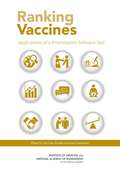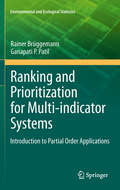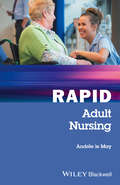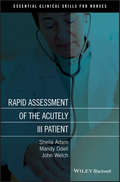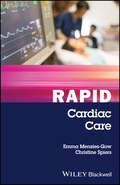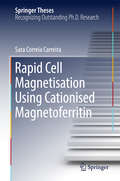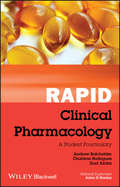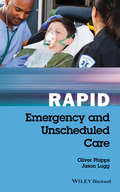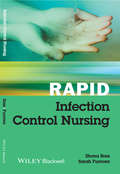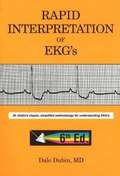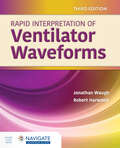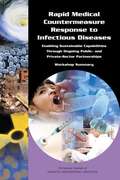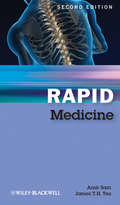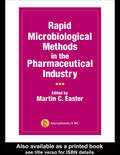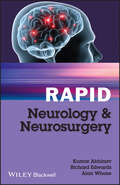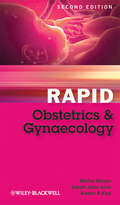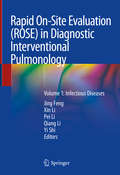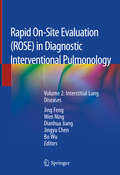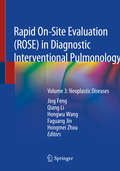- Table View
- List View
Ranking Vaccines: Use Case Studies and Data Framework
by Guruprasad MadhavanSMART Vaccines - Strategic Multi-Attribute Ranking Tool for Vaccines - is a prioritization software tool developed by the Institute of Medicine that utilizes decision science and modeling to help inform choices among candidates for new vaccine development. A blueprint for this computer-based guide was presented in the 2012 report "Ranking Vaccines: A Prioritization Framework: Phase I. " The 2013 "Phase II" report refined a beta version of the model developed in the Phase I report. "Ranking Vaccines: Applications of a Prioritization Software Tool: Phase III: Use Case Studies and Data Framework" extends this project by demonstrating the practical applications of SMART Vaccines through use case scenarios in partnership with the Public Health Agency of Canada, New York State Department of Health, and the Serum Institute of India. This report also explores a novel application of SMART Vaccines in determining new vaccine product profiles, and offers practical strategies for data synthesis and estimation to encourage the broader use of the software.
Ranking and Prioritization for Multi-indicator Systems
by Ganapati P. Patil Rainer BrüggemannThis book provides axioms of partial order and some basic material, for example consequences of "criss-crossing" of data profiles, the role of aggregations of the indicators and the powerful method of formal concept analysis. The interested reader will learn how to apply fuzzy methods in partial order analysis and what 'antagonistic indicator' means.
Rapid Adult Nursing
by Andrée Le MayRapid Adult Nursing is an essential read for all adult nursing students, as well as a refresher for qualified adult nurses, and a 'dip into text' for other healthcare professionals. Designed for quick reference, it maps on to the essential clinical skills and knowledge required for pre-registration adult nurses, and captures the essentials of adult nursing care in an easy to read, and highly accessible format. Covering all the key topics in adult nursing, this concise and easy-to-read title is the perfect quick-reference book for student adult nurses.
Rapid Assessment of the Acutely Ill Patient
by Jo Welch Sheila Adam Mandy OdellRapid Assessment of the Acutely Ill Patient sets out the principles and practices needed for early recognition and assessment of patients either at risk of or showing signs of acute deterioration, or those recently relocated from higher levels of care. The focus is on patient assessment, interpretation and evaluation of data, immediate management of significant problems, ongoing and further assessments in order to improve clinical outcomes. Rapid Assessment of the Acutely Ill Patient provides a framework for a systematic initial patient assessment and explores principles of effective assessment. Body systems are considered in order of life-threatening priority following the ABCDE approach, dealing with the assessment and management of airway, breathing, circulation, disability - and everything else; covering topics such as visual, palpatory and auscultatory assessment, use of additional documented information (charts, notes etc), and interpreting diagnostic investigations. Methods to ensure effective communication and team-working are also discussed.Key featuresPart of the Essential Clinical Skills for Nurses seriesAimed at nurses working in wards and specialist departmentsExplores the assessment skills required for a rapid response to a patient at risk of becoming acutely unwellEnables students and practitioners to develop practical and interpretative skillsProvides a framework for assessment and principles of first line treatmentIncludes 'Look', 'Listen', 'Feel' and 'Measure' iconsSheila Adam is Head of Nursing, Specialist Hospitals Board, UCL Hospitals NHS Foundation Trust and author of Nursing in Critical Care: Science and Practice (now in its 2nd edition), The Oxford Handbook of Critical Care Nursing and Nutrition in the Critically Ill.John Welch is Nurse Consultant in Critical Care, University College London Hospitals NHS Foundation Trust, and former Chair of the National Outreach Forum.Mandy Odell is Nurse Consultant in Critical Care, Royal Berkshire NHS Foundation Trust, Nurse and Allied Health Professional representative for the Intensive Care Society and former Chair of the British Association of Critical Care Nurses.
Rapid Cardiac Care
by Emma Menzies-Gow Christine SpiersRapid Cardiac Care is an indispensable resource for all frontline staff working with acutely ill patients. Offering easy access to the knowledge base needed to provide rapid, safe and effective cardiac care, it is ideal for newly qualified healthcare professionals including, nurses, paramedics, cardiac technicians, junior medics, and physiotherapists. Key features include: Essential information to support the assessment of the cardiac patient including focused history taking and physical assessment, rhythm interpretation and 12-lead ECG assessment Practical guidance on how to care for patients with cardiac emergencies, including acute coronary syndromes, arrhythmias, heart failure and cardiac arrest A quick reference A-Z section that explores a wide range of conditions affecting the heart, each with a comprehensive overview of patient presentation and strategies to guide patient assessment and management Diagrams and images are provided to facilitate learning
Rapid Cell Magnetisation Using Cationised Magnetoferritin
by Sara Correia CarreiraBringing together nanoscience with stem cell and bacterial cell biology, this thesis is truly interdisciplinary in scope. It shows that the creation of superparamagnetic nanoparticles inside a protein coat, followed by chemical functionalisation of the protein surface, provides a novel methodology for cell magnetisation using incubation times as short as one minute. Crucially, stem cell proliferation and multi-lineage differentiation capacity is not impaired after labelling. Due to the unspecific labelling mechanism, this thesis also shows that the same magnetic protein nanoparticles can be used for rapid bacterial magnetisation. Thus, it is possible to magnetically capture and concentrate pathogens from clinical samples quickly and highly efficiently.
Rapid Clinical Pharmacology
by Andrew Batchelder Charlene Rodrigues Ziad Alrifai Adrian G. StanleyThis pocket reference guide is a must for all medical students and junior doctors preparing for exams in pharmacology or needing a rapid reminder during a clinical attachment. In light of the growing pressures on those who prescribe drugs to patients, increasing emphasis has been placed on the importance of pharmacology in the undergraduate medical curriculum. Rapid Clinical Pharmacology, with its concise, easy-to-use approach, offers an appealing format for students to use in both clinical practice and exam preparation and its 'one-page per drug/class' layout easily facilitates the generation of a personal student formulary. Each chapter of the book mirrors each section of the BNF to allow easy cross-referencing and then each chapter is divided into consistent sections as per other books in the Rapid series. Rapid Clinical Pharmacology will also be available as a mobile application for iPhone, iPod Touch, iPad and Blackberry. See wiley. com/go/mededapps for further details.
Rapid Clinical Pharmacology: A Student Formulary (Rapid #32)
by Andrew Batchelder Charlene Rodrigues Ziad AlrifaiThis pocket reference guide is a must for all medical students and junior doctors preparing for exams in pharmacology or needing a rapid reminder during a clinical attachment. In light of the growing pressures on those who prescribe drugs to patients, increasing emphasis has been placed on the importance of pharmacology in the undergraduate medical curriculum. Rapid Clinical Pharmacology, with its concise, easy-to-use approach, offers an appealing format for students to use in both clinical practice and exam preparation and its ‘one-page per drug/class' layout easily facilitates the generation of a personal student formulary. Each chapter of the book mirrors each section of the BNF to allow easy cross-referencing and then each chapter is divided into consistent sections as per other books in the Rapid series. Rapid Clinical Pharmacology will also be available as a mobile application for iPhone, iPod Touch, iPad and Blackberry. See wiley.com/go/mededapps for further details.
Rapid Emergency and Unscheduled Care
by Jason Lugg Oliver PhippsRapid Emergency and Unscheduled Care outlines the fundamental skills and knowledge necessary to work in the emergency and unscheduled care setting, including pre-hospital care. Highlights key history/assessment knowledge, identifying red-flags, and defining and assisting with making a diagnosis Explores over 140 presenting ailments, with core information on definition, aetiology, epidemiology, history, examination, investigations and management. Incorporating words of wisdom and advice from experienced practitioners, this A-Z reference book is essential for all those working in emergency care settings, including doctors, nurse practitioners, nurses, paramedics, and allied health professionals.
Rapid Eye Movement Sleep
by S. R. Pandi-Perumal Birendra N. Mallick Robert W. Mccarley Adrian R. MorrisonSpanning over half a century of investigation into Rapid Eye Movement (REM) sleep, this volume provides comprehensive coverage of a broad range of topics in REM sleep biology. World renowned researchers and experts are brought together to discuss past and current research and to set the foundation for future developments. Key topics are covered in six sections from fundamental topics (historical context and general biology) to cutting-edge research on neuronal regulation, neuroanatomy and neurochemistry, functional significance and disturbance in the REM sleep generating mechanism. A reference source for all aspects of REM sleep research, it also incorporates chapters on neural modelling, findings from non-human species and interactions between brain regions. This is an invaluable resource, essential reading for all involved in sleep research and clinical practice.
Rapid Infection Control Nursing (Rapid Ser.)
by Sarah Furrows Shona RossThe Rapids are a series of reference and revision pocket books that cover key facts in a simple and memorable way. Each book contains the common conditions that students and newly qualified nurses encounter on the wards, in the community, and on placements. Only the basic core relevant facts are provided to ensure that these books are perfect and concise rapid refreshers.Rapid Infection Control Nursing is an essential read for all frontline nursing staff working in hospitals or community settings. Designed for quick reference, it explores the essential principles of infection control before moving on to an A-Z of the most commonly found infections. Each entry covers how the infection is spread, duration of the infectious period, key infection-control precautions, staff considerations, visitor information, and patient transfer advice.Covering all the key topics in infection prevention and control, this concise and easy-to-read title is the perfect quick-reference book for the wards.
Rapid Interpretation of EKG's
by Dale DubinThe reader's rapid assimilation of medical concepts is the key to the continuing success of this best-selling book. A caption explains the concept illustrated on each page, and a few simple sentences reinforce the concept with interactive (programmed) learning, which links to the following page. Dr Dubin's light and entertaining style, known world-wide, makes learning enjoyable. Practice twelve-lead tracings at the end establish self-confidence, and summarised reference sheets with examples (designed to be copied) provide an excellent review. Most recently updated in February 2006.
Rapid Interpretation of Ventilator Waveforms
by Robert J. Harwood Jonathan WaughIdeal for students, as well as practicing professionals, Rapid Interpretation of Ventilator Waveforms, Third Edition guides readers from the basics in ventilator design, function, and management to advanced interpretations of ventilator waveforms. It's NEW full-color design provides clarity in the waveforms and each section is color-coded for ease of use. Intended to serve as a complement to a mechanical ventilation textbook, as well as a convenient reference, the text provides clear, easy-to-read illustration and examples of real waveforms to enhance learning. Every new print copy includes Navigate Advantage Access which unlocks an interactive eBook, Workbook, additional case studies, and slides in PowerPoint format.
Rapid Medical Countermeasure Response to Infectious Diseases: Workshop Summary
by Engineering Medicine National Academies of SciencesEmerging infectious disease threats that may not have available treatments or vaccines can directly affect the security of the world's health since these diseases also know no boundaries and will easily cross borders. Sustaining public and private investment in the development of medical countermeasures (MCMs) before an emerging infectious disease becomes a public health emergency in the United States has been extremely challenging. Interest and momentum peak during a crisis and wane between events, and there is little interest in disease threats outside the United States until they impact people stateside. On March 26 and 27, 2015, the Institute of Medicine convened a workshop in Washington, DC to discuss how to achieve rapid and nimble MCM capability for new and emerging threats. Public- and private-sector stakeholders examined recent efforts to prepare for and respond to outbreaks of Ebola Virus Disease, pandemic influenza, and coronaviruses from policy, budget, and operational standpoints. Participants discussed the need for rapid access to MCM to ensure national security and considered strategies and business models that could enhance stakeholder interest and investment in sustainable response capabilities. This report summarizes the presentations and discussions from this workshop.
Rapid Medicine (Rapid #18)
by Amir H. Sam James T. TeoThis pocket reference and revision guide is a must for all medical students and junior doctors preparing for major exams in clinical medicine or needing a rapid reminder of essential facts during a clinical attachment. Now thoroughly updated, this new edition combines the first editions of Rapid Medicine and Rapid Differential Diagnosis and contains reference to over 200 common medical conditions and diseases and 350 signs and symptoms encountered on a daily basis on the wards, in clinics and in exams. This concise, no-nonsense reference is presented in an A-Z format for easy access to information, and includes a thematic index with conditions sorted by speciality making it an ideal companion in any clinical situation.
Rapid Medicines Management for Healthcare Professionals (Rapid)
by Simon Young Ben Pitcher Paul DeslandesRAPID Medicines Management for Healthcare Professionals Rapid Medicines Management for Healthcare Professionals is an accessible, easy-to-use reference guide to safe and effective use of medicines in clinical practice. Introducing readers to the key principles of pharmacology and medicines management, this book addresses the essential elements encountered in healthcare practice. Clear, concise chapters explain the principles of clinical pharmacology, examine the formulation, administration, and monitoring of medicines, outline the characteristics of common drugs, and explore practical considerations such as vaccinations and evidence-based medicine. Blank templates allow readers to create customised drug information sheets, whilst a glossary enables easy access to explanations of key pharmacological concepts and terminology. Offers quick reference to essential pharmacological knowledge Covers both pharmacological theory and real-world applications of managing medicines Includes practical information on commonly prescribed drugs Complements standard reference sources such as the British National Formulary (BNF) Helping readers make informed medicines management decisions and render the best possible care, Rapid Medicines Management for Healthcare Professionals is a valuable resource for students and qualified nurses, as well as other healthcare professionals with an interest in medicine management.
Rapid Mental Health Nursing
by Grahame Smith Rebecca RylanceA concise, pocket-sized, A-Z rapid reference handbook on all the essential areas of mental health nursing, aimed at nursing students and newly qualified practitioners. Covers a broad range of mental health disorders, approaches interventions and conditions Easy to locate practical information quickly in a pocket sized, rapid reference format The topics and structure are mapped on to the NMC's (2010) Standards for Pre-registration Nursing Education and their required essential skills and knowledge.
Rapid Microbiological Methods in the Pharmaceutical Industry
by Martin C. EasterIn recent years there has been increased interest in the possibility of rapid microbiological methods offering enhanced potential error detection capabilities. However, these methods raise a number of questions, such as how to validate new methods, will they be accepted by the pharmacopoeias, and, most importantly, how will the regulators respond?
Rapid Midwifery
by Kate Taylor Sarah Snow Jane CarpenterA concise, pocket-sized, rapid reference handbook on all key areas of midwifery, aimed at students and newly qualified staff. Covers a broad range of midwifery topics which are mapped against the 6Cs essential to compassionate midwifery care Each section is structured around the key criteria used in midwifery examinations Bite-sized information supported by the latest evidence-base, making it the perfect revision tool for OSCEs and written examinations Every chapter includes key points, essentials of midwifery care, professional accountability, and links to further resources
Rapid Neurology and Neurosurgery
by Richard Edwards Alan Whone Kumar AbhinavRapid Neurology and Neurosurgery is a must for all medical students and junior doctors - it is a quick and easy on-the-ward or clinic reference and the perfect revision tool for those approaching finals, undergraduate neurology and neurosurgery examinations, and the Membership of Royal College of Surgeons (MRCS) examinations.It provides a concise, structured approach to neurology and neurosurgery learning, covering key facts in a simple and memorable way:Part I - The Basics - features the basic principles and facts essential for a good understanding of neurology and neurosurgery and includes sections on relevant neuroanatomy; neurological history and examination; and investigations including neurophysiology and neuroradiology. MRI and CT scans are included throughout the text.Part II - Complaints: face to face with the patient - features OSCE-style and the viva-voce examination preparation and has chapters on presenting complaints with relevant and selected questions to ask for establishing the differential diagnoses (presented in a table) with basic investigations and management.Part III - Conditions: applying the basics - presents important clinical conditions with sections on definition; epidemiology; aetiology; associations/risk factors; pathology; history; examination; investigations; management; complications; prognosis and a list of differential diagnoses usually in a table with general clinical information and distinguishing information to exclude the alternative diagnoses.Each chapter also includes key points to remember and highlights key facts.Rapid Neurology and Neurosurgery contains only the essential, core, and relevant facts in a concise, pocket-sized, 'rapid' refresher providing a thorough foundation of neurology and neurosurgery knowledge allowing you to excel in the examinations.
Rapid Obstetrics & Gynaecology
by Misha Moore Sarah-Jane Lam Adam R KayThis pocket reference and revision guide is a must for all medical students and junior doctors preparing for major exams in obstetrics and gynaecology or needing a rapid reminder during a clinical attachment. Now thoroughly updated, this second edition has been re-ordered into three sections - covering obstetrics, gynaecology, and procedures - to provide a more systematic and ordered approach to learning that takes into consideration the natural division within the specialty. Covering all key topics in Obstetrics and Gynaecology, this succinct account of the core and common conditions found in clinical settings and exams is the ideal refresher covering just the basic, relevant facts.
Rapid On-Site Evaluation (ROSE) in Diagnostic Interventional Pulmonology: Volume 1: Infectious Diseases
by Xin Li Yi Shi Qiang Li Pei Li Jing FengThis book provides a comprehensive overview of the "real-time accompany technique" for diagnostic interventional pulmonology, known as rapid on-site evaluation (ROSE). It also offers readers a detailed understanding of how to interpret ROSE cytological slides, which is key to the interventional procedure itself and valuable in the analysis of the infectious disease status. The first part discusses the ROSE procedure, clarifying the role of ROSE in the diagnosis of respiratory diseases, while further sections address correct work processes and the implications of ROSE, incorporating multidisciplinary perspectives on respiratory diseases, interventional pulmonology, pathology, clinical microbiology and infectious diseases. This helps practitioners, such as pulmonologists, interventional physicians, radiologists, critical care physicians, haematologists and rheumatologists, establish standardized clinical practices. The book also covers detailed clinical workups, including presentations of lesions, which are of interest to physicians from other specialties.
Rapid On-Site Evaluation (ROSE) in Diagnostic Interventional Pulmonology: Volume 2: Interstitial Lung Diseases
by Bo Wu Jing Feng Wen Ning Dianhua Jiang Jingyu ChenThis book demonstrates the recent advances in rapid on-site evaluation (ROSE) for differential diagnosis of interstitial lung disease (ILD). Interstitial lung disease is a group of diffuse parenchymal lung disorders affecting the interstitium, a part of the lung's anatomic structure, causing inflammation, scarring, or excess fluid. ILDs include interstitial pneumonia, idiopathic pulmonary fibrosis, nonspecific interstitial pneumonitis, cryptogenic organizing pneumonia and sarcoidosis, which are associated with various degrees of morbidity and mortality rates. ROSE has proven its value in diagnosis with routine transbronchial lung biopsy (TBLB) procedures, especially in difficult clinical cases. The first part of the book discusses the principals of performing ROSE procedures, reviews the basic concepts and summarizes the distribution and morphology of tracheal/ bronchial/ pulmonary cells. The second part covers specific interstitial disorders, including a number of difficult and rare cases, and features iCT images and cytological illustrations. Providing readers with valuable insights, the book is an important resource for practitioners involved in the care and treatment of patients with ILD. This book is part of the 4-volume collection ROSE in Diagnostic Interventional Pulmonology.
Rapid On-Site Evaluation (ROSE) in Diagnostic Interventional Pulmonology: Volume 3: Neoplastic Diseases
by Qiang Li Jing Feng Hongwu Wang Faguang Jin Hongmei ZhouThis book offers cutting-edge evidence on using rapid on-site evaluation (ROSE) for the diagnosis of neoplastic diseases in pulmonology. ROSE has become an efficient interventional diagnostics tool and important reference for lung disease differentiation, increasing the adequacy rate, diagnostic yield and accuracy of interventional pulmonary procedures. By performing a rapid stain in the bronchoscopy suite, with evaluation by a trained physician, ROSE can be used to ensure the collection of suitable and sufficient material for ancillary studies in an era of caner-targeted therapy.ROSE holds considerable value in terms of evaluating sampling adequacy for further immunohistochemistry testing, microbiology studies, flow cytometry analysis, and molecular assays, providing a preliminary diagnosis for patient care. The first part of the book discusses the key principles for performing ROSE procedures and reviews key anatomical structures in the lung. It also covers typical cellular characteristics on the ROSE scale for pulmonary solid malignancies.The second part of the book features abundant figures and illustrations of ROSE cytopathology in common neoplastic diseases, e.g. adenocarcinoma, squamous-cell carcinoma and small cell lung cancer, while also exploring more unusual types, e.g. pneumonia-type carcinoma of the lung (PTCL), mucinous adenocarcinoma, lung mixed carcinoma, pulmonary metastases from extrapulmonary primary tumors, large cell neuroendocrine carcinoma (LCNEC), and lymphoma. This book is part of the 4-volume collection ROSE in Diagnostic Interventional Pulmonology.
Rapid On-Site Evaluation (ROSE) in Diagnostic Interventional Pulmonology: Volume 4: Metagenomic Sequencing Application in Difficult Cases of Infectious Diseases
by Wen Li Bo Wu Chen Meng Jing Feng Erlie JiangThis book covers up-to-date evidence of Rapid on-site evaluation (ROSE) for diagnosis of rare disease and used combined with metagenomic sequencing technique in clinical scenarios. ROSE has becoming an efficient interventional diagnostics tool and important reference for lung diseases differentiation, increasing the adequacy rate, diagnostic yield and accuracy of the interventional pulmonary procedures. ROSE has its value in the field of evaluating sampling adequacy for further immunohistochemistry, microbiology studies, flow cytometry analysis, and molecular assays; DNA analysis of biopsy specimens using sequencing technique is performed to provide clue of etiology, which is an emerging pathway for clinical dilemmas. The first part of the book discusses the principals of performing ROSE procedures and reviews the basic concepts and summarized knowledge of key anatomical structures in lung. Figures of ROSE cytopathology, together with clinical data, results of metagenomic sequencing technique are presented to demonstrate how the difficulties in clinical practice could be tackled with the help of advanced techniques. Further application direction and perspective are also discussed, which provides researchers with more insights on the discipline and techniques. This book is part of the 4-volume collection ROSE in Diagnostic Interventional Pulmonology.
